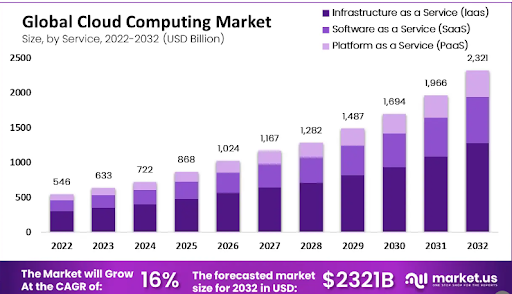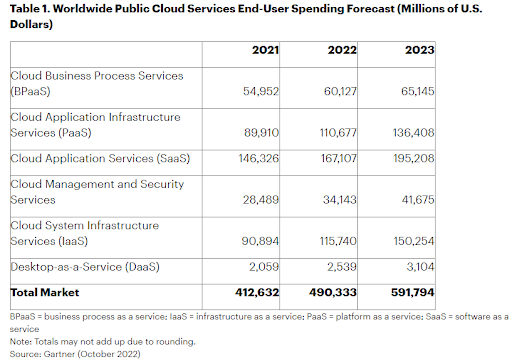The cloud is snowballing. According to market analysis by Gartner, global IT spending on cloud-based computing is expected to rise from USD 490.3 billion in 2022 to USD 591.8 billion in 2023.

The explosive growth of cloud-based services, applications, and infrastructure has made businesses re-evaluate their cloud-based approach and anticipate how it might impact industry business models in the next few years.
Since cloud computing is obviously the future, let us explore what it is, as well as its other aspects, in the sections below.
What Is Cloud Computing?
Cloud computing refers to an organization providing access to a certain part, or all, of its IT infrastructure with the help of the Internet rather than any physical means, such as an offline data center, etc.
Its benefits are that you don’t need to worry about managing either hardware or software upgrades or any other aspects of infrastructure management because the cloud provider takes care of it.
Cloud Computing is, therefore, a flexible and scalable model for delivering IT services.
The term “cloud computing” was coined in 1996 by two employees of a company known as Compaq Computer. They were George Favaloro and Sean ‘O Sullivan. It began to gain prominence in mid-2006 when technology giants Google and Amazon began to utilize the term.
Leaders In Cloud Computing
The cloud computing market is expected to grow at a CAGR of 16% from 2023-2032. While many companies provide cloud services, some of them stand out from the crowd, as seen in the table below.

Some of the other leaders of cloud computing are:
- Amazon Web Services (AWS)
AWS is one of the most well-known players. It provides services for:
- Businesses
- Enterprise customers and individuals who want their primary storage and bandwidth needs met without adding to their infrastructure
- Microsoft Azure
Azure was launched by Microsoft back in 2014 as an effort to compete with AWS. The company offers a wide range of services through its platform, such as:
- Databases
- Storage
- Networking and Virtual machines (VMs), etc.
- IBM
It is another major player in cloud computing, as it has over 100 years of experience behind it, as well as an extensive portfolio of products and services. The company offers various business tools, such as the following:
- Watson AI (artificial intelligence)
- Blockchain technology, etc.
This technology giant has been around since 1998, which hints at its vast experience developing new technologies and software.
While its primary focus is on providing search engine services, it also offers other valuable applications through its platforms, such as:
- Google Docs
- Google Mail
- Google Maps
- Google Drive, etc.
Let us explore some cloud computing trends in the sections below.
Emerging Trends In Cloud Computing
Cloud computing is a vital part of the IT landscape. It has revolutionized how we work by helping and supporting businesses to grow. This growth is possible by focusing on core competencies and building and deploying applications quickly and easily.
Edge Computing
Edge computing refers to the technique of processing data in a location closer to the data source or the data generation point.
This approach can help businesses:
- Improve their performance
- Save money by optimizing bandwidth usage
- Reducing latency issues
Businesses that utilize edge computing are also at an advantage as their users can access their files even if there’s a problem with their internet connection or server availability.
Observability
In a world where you can’t keep an eye on everything at once, observability is a critical aspect for ensuring the continued performance of your applications as per customer expectations.
This expectation is why cloud providers like Google and Amazon have taken the necessary steps toward making observability easier by providing tools such as:
- Stackdriver for Google Cloud Platform (GCP)
- CloudWatch for AWS, respectively
These tools help provide logs and metrics that aid developers in identifying performance bottlenecks in their applications, which allows them to resolve issues before they significantly impair your organizational operations.
AI and ML
AI, or Artificial Intelligence, is a subfield of computer science that deals with devices that perform everyday tasks.
On the other hand, ML, or Machine Learning, utilizes AI techniques to help computers learn from available sets of data without being explicitly programmed.
For instance, AI and ML can:
- Assist businesses in predicting consumer behavior, which will help them personalize their offering in a seamless manner
- Help organizations manage risk by spotting patterns in vast data that human analysts might otherwise miss
Disaster Recovery
Crisis or disaster recovery allows businesses to restore their data quickly in the event of an unfortunate occurrence, such as a natural disaster.
This is because all your data is stored virtually, which prevents it from being harmed due to the events mentioned above.
Compliance Technology
Keeping up with the standards and laws that are always changing is one of the major problems for organizations to achieve compliance. Compliance technology can help in this situation by offering automated solutions to monitor, identify, and immediately fix any compliance problems.
Cloud computing has allowed organizations to access compliance technology through Software-as-a-Service (SaaS) offerings, which offer on-demand access to compliance tools and services without requiring any on-premise infrastructure.
Particularly for small and medium-sized organizations (SMEs) who previously lacked the means to invest in compliance technology, this has significantly decreased the cost and complexity of implementing compliance technology.
Multi and Hybrid Cloud Solutions
When a private cloud storage owned and controlled by an organization is combined with a public cloud, like Google Cloud or AWS, it creates a hybrid cloud solution.
Businesses can use this combination to take advantage of private and public cloud storage systems.
This is because the ability to access many cloud storage systems through a single interface provided by multi-cloud solutions makes it simpler for users to manage their data across several platforms.
Kubernetes
Kubernetes is an open-source system for automating container operations, such as:
- Deployment
- Scaling
- Management
These containers are lightweight virtual environments that run applications in environments that are particular to each of them without affecting other containers running on the same resource pool (server).
Kubernetes manages all this complexity by simultaneously managing containers across multiple servers through its built-in orchestration engine.
It allows developers to:
- Quickly deploy and scale their applications on any cloud provider
- Move from one infrastructure environment to another without changing the application code
Serverless Computing
It allows developers to build applications without managing servers or other infrastructure resources.
Instead, businesses can deploy applications on a pay-as-you-go model, meaning their developers don’t have to worry about setting up and maintaining servers or other resources.
This aspect of cloud computing can thus save time and money for developers who:
- Don’t have experience managing large amounts of infrastructure resources
- Need to be better versed in managing those resources effectively
Green Computing Initiatives
Many providers have started offering green computing initiatives as part of their offerings.
This trend means that customers can opt for more environmentally friendly options when deploying their applications in the cloud; for example, by:
- Using renewable energy sources instead of non-renewable ones
- Implementing efficient cooling systems in their data centers
IoT
Cloud computing is commonly known as the Internet of Things (IoT) because it connects various physical devices with others, such as:
- Devices
- People
- Businesses
The impact of IoT will be felt across all industries, including retail, healthcare, and manufacturing.
This is because the technology can collect real-time data from an array of objects or devices and analyze it to make better business decisions.
For example, retailers can leverage IoT technology to gain insights into customer shopping patterns based on store locations, proximity to products on shelves, etc.
DevSecOps
DevSecOps aims to improve application security by integrating security testing into the DevOps workflow. This integration allows developers to identify issues before they reach production while providing them with the tools to fix them quickly. Companies can configure the DevOps server with HTTPS, aka SSL certificate, which increases security.
DevSecOps provides the following through automation:
- Continuous security monitoring
- Testing
- Enforcement through automation
Summary
Simply put, the cloud is here to stay. After all, there is no better evidence of it than its advanced features and increased ease of use we’re starting to see across the cloud computing landscape.
Some of the ways in which cloud computing has positively impacted our lives are:
- Allowing IaaS or Infrastructure-as-a-Service platforms to scale in a seamless manner
- Allowing for the self-contained identity authentication of SaaS or Software-as-a-Service offerings, etc.
Jinal Lad Mehta is a digital marketer at Middleware AI-powered cloud observability tool. She is known for writing creative and engaging content. She loves to help entrepreneurs get their message out into the world. You can find her looking for ways to connect people, ideas, and products.
